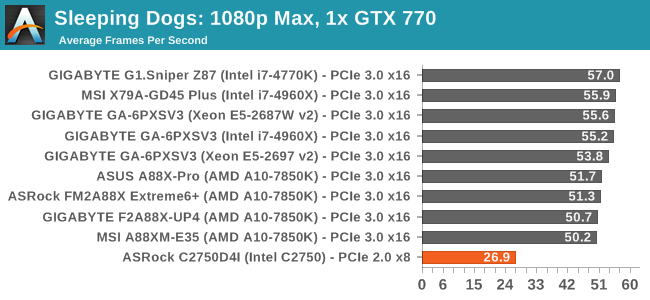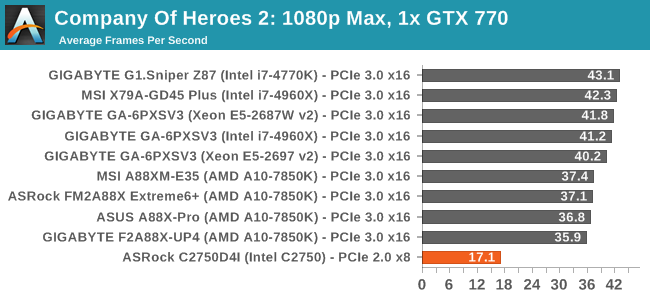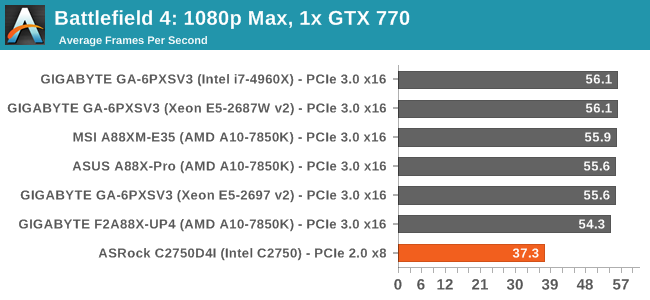ASRock Rack C2750D4I Review: A Storage Motherboard with Management
by Ian Cutress on April 29, 2014 9:00 AM EST- Posted in
- Motherboards
- Storage
- Atom
- ASRock
- Silvermont
- Enterprise
- server
- Avoton
Sleeping Dogs
Sleeping Dogs is a benchmarking wet dream – a highly complex benchmark that can bring the toughest setup and high resolutions down into single figures. Having an extreme SSAO setting can do that, but at the right settings Sleeping Dogs is highly playable and enjoyable. We run the basic benchmark program laid out in the Adrenaline benchmark tool, and the Xtreme (1920x1080, Maximum) performance setting, noting down the average frame rates and the minimum frame rates.

| Sleeping Dogs, 1080p Max | ||
| NVIDIA | AMD | |
| Average Frame Rates | ||
| Minimum Frame Rates | ||
Company of Heroes 2
Company of Heroes 2 also can bring a top end GPU to its knees, even at very basic benchmark settings. To get an average 30 FPS using a normal GPU is a challenge, let alone a minimum frame rate of 30 FPS. For this benchmark I use modified versions of Ryan’s batch files at 1920x1080 on High. COH2 is a little odd in that it does not scale with more GPUs with the drivers we use.

| Company of Heroes 2, 1080p Max | ||
| NVIDIA | AMD | |
| Average Frame Rates | ||
| Minimum Frame Rates | ||
Battlefield 4
The EA/DICE series that has taken countless hours of my life away is back for another iteration, using the Frostbite 3 engine. AMD is also piling its resources into BF4 with the new Mantle API for developers, designed to cut the time required for the CPU to dispatch commands to the graphical sub-system. For our test we use the in-game benchmarking tools and record the frame time for the first ~70 seconds of the Tashgar single player mission, which is an on-rails generation of and rendering of objects and textures. We test at 1920x1080 at Ultra settings.

| Battlefield 4, 1080p Max | ||
| NVIDIA | AMD | |
| Average Frame Rates | ||
| 99th Percentile Frame Rates | ||













85 Comments
View All Comments
S.D.Leary - Tuesday, April 29, 2014 - link
Actually, for the SMB/Home version I was thinking more along the lines of keeping all the management, but dropping the TPM.Dropping BOTH extra SATA switches. (No real need for these on a home Media Server, and honestly for many/most SMB, four 6TB drives would be more than enough)
Updating USB to 3.1 status
A digital video output.
Dropping the COM port
Thunderbolt 2 for external expansion (that way a SMB that was growing could add a storage chassis if needed)
And for Silverstone, a chassis with similar capabilities to the DS380, but with the following changes...
Drop 3.5" support. Ideally 4 Hot Swap 2.5" external bays, and one or two internal 2.5" bays.
An option for a Slim Optical drive.
Preferably a horizontal orientation to fit into an A/V setting.
Support for double wide normal graphics cards. This would probably necessitate a riser and horizontal orientation of the card.
Ian! A question for you. Do you have something that could test real time transcoding of Audio and Video? Both with and without a GPU?
SDLeary
Computer Bottleneck - Tuesday, April 29, 2014 - link
I like the idea of the consumer version as well.Make mine a C2550 and no additional SATA controllers. (SOC has six native SATA).
LastQuark - Monday, May 5, 2014 - link
You're looking at the wrong board. Check Bay Trail solutions. It will be perfect for your needs.swizeus - Tuesday, April 29, 2014 - link
Interesting as how Anandtech includes gaming benchmark for a storage centric motherboard, and with a decent card, it still be able to cope. What can you expect from a 25W CPU thoughLastQuark - Monday, May 5, 2014 - link
+1. It was a gross oversight of what this board is intended for.-=Hulk=- - Tuesday, April 29, 2014 - link
1. All recent Atoms (including Avaton's) support hardware AES acceleration:http://ark.intel.com/products/77987
2. 43W idle for the 5350??? What the hell??? I think your values are totally wrong....
50W for the C2758??? Look at that test with a similar Supermicro Mini-ITX motherboard:
http://www.servethehome.com/intel-avoton-rangeley-...
Ian Cutress - Tuesday, April 29, 2014 - link
Values aren't wrong, but the PSU is inefficient. Those values are also a full system build. I have to keep the same power supply across reviews for meaningful comparisons on the same efficiency curve, which I mention in the blurb above the power readings. I also mention that due to that fact, it's more a qualitative comparison than a quantitative.DanNeely - Tuesday, April 29, 2014 - link
I understand why you're using the same PSU for all your tests. But for really small/low power systems I'd suggest adding a second power test with a much smaller PSU, similar to how the old cast thermal tests for small enclosures were often done with both a big high power GPU and a small lower power one. The 1250W monster would allow for direct comparison with high power gaming systems; a second number from a ~250W PSU would provide a second number that would be more inline with typical use.watersb - Tuesday, April 29, 2014 - link
Wow! Thanks for writing about this one! I build small-office storage servers, and this might be exactly what we need!watersb - Tuesday, April 29, 2014 - link
"Users have been reporting that in Linux and FreeBSD, high intensity read/write workloads cause the controller to reset and elements to any software array are lost."Hmm. Not good. I see this with Sil3132 controllers, too. The PCIe x8 slot would let me install a modest controller like the old Intel/LSI SASUCI8, but that push the system price back into SuperMicro territory.